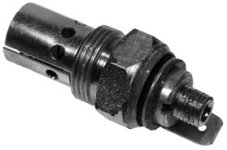Re: Kama 554 fuel return hoses, anyone know where to
</font><font color="blue" class="small">( fuel will be setting in the lowest part of the return line of that splice, so a large supply is not needed.)</font>
There is some logic to that, I guess. The operating principle being that gravity should have permited the ThermoStart supply line to partially fill as a normal course of (previously) operating the tractor. Compared to the standalone reservior though, I still have some doubts about consistent availability of fuel after extended idle periods.
</font><font color="blue" class="small">( If it injected fuel while cranking it would do nothing at all, we all know that liquid fuel will not burn in any engine, it needs to be a fine vapor or in the diesels case a fine mist.)</font>
Here's where I don't think I've gotten my point across though. Heat first, crank second. Do not confuse the pre-heater (see attachment) with the fuel injectors. The pre-heater warms up air with electricity, not cranking. The injectors atomize fuel - only by cranking. And if I gave the impression that raw fuel was introduced into the precombustion chambers, let me clear that up now.
If you already had "a fire" in the intake manifold, it would cause serious pre-ignition problems. The results can be compared to problems encountered with the indiscriminate use of ether or starting fluid; cylinders firing before the crankshaft is positioned for the power stroke.
What you've really got is something resembling a butane lighter flame heating up the air inside the intake manifold. Here's the sequence as best I understand it. When you supply 12v to the pre-heater, a coil something like a car's cigarette lighter begins to glow. The heat soon causes a spring to open a ball valve, letting in a tiny amount of diesel fuel from the supply line. As the diesel slowly passes through the ball valve - then the heating element - it burns something on the order of a pilot light or butane lighter. After a heating cycle appropriate to the ambient temperature, you can crank the engine. Each intake stroke sucks the now-heated air into the cylinders - sequentially. Once in the cylinder, it mixes with the (cold) atomized fuel on the compression stroke, and subsequently detonates to provide the power stroke. Removing 12v from the pre-heater allows it to cool sufficiently to where the ball valve spring returns to it's original position - and fuel to/through the preheater is stopped.
//greg//
